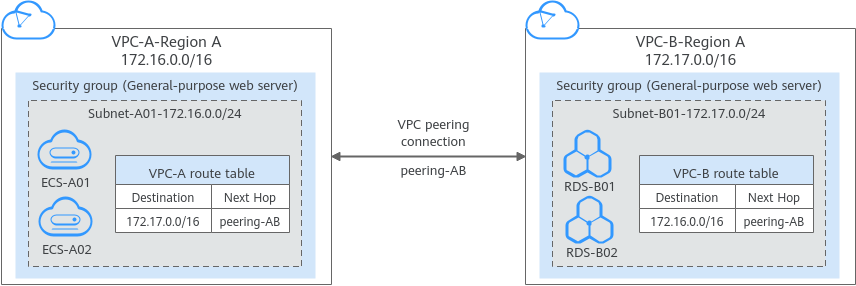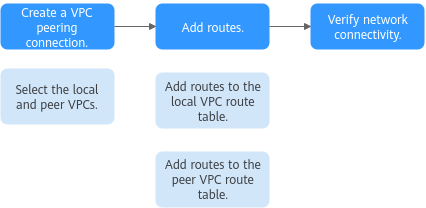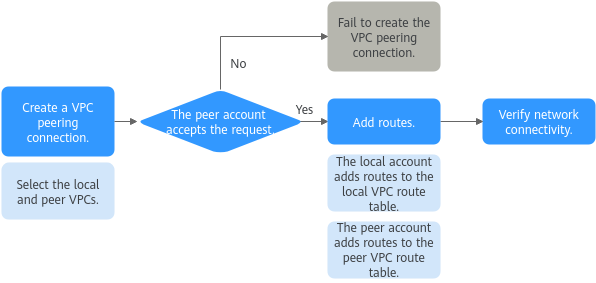VPC Peering Connection Overview
What Is a VPC Peering Connection?
A VPC peering connection connects two VPCs to enable them to communicate using private IP addresses. The VPCs to be peered can be in from same account or different accounts, but must be in the same region.
Figure 1 shows an application scenario of VPC peering connections.
- There are two VPCs (VPC-A and VPC-B) in region A that are not connected.
- Service servers (ECS-A01 and ECS-A02) are in VPC-A, and database servers (RDS-B01 and RDS-B02) are in VPC-B. The service servers and database servers cannot communicate with each other.
- You need to create a VPC peering connection (peering-AB) between VPC-A and VPC-B so the service servers and database servers can communicate with each other.
Figure 1 Two VPCs connected by a VPC peering connection

VPC Peering Connection Creation Process
A VPC peering connection can only connect VPCs in the same region.
- If two VPCs are in the same account, the process of creating a VPC peering connection is shown in Figure 2.
For details about how to create a VPC peering connection, see Creating a VPC Peering Connection to Connect Two VPCs in the Same Account.
Figure 2 Process of creating a VPC peering connection between VPCs in the same account

- If two VPCs are in different accounts, the process of creating a VPC peering connection is shown in Figure 3.
For details about how to create a VPC peering connection, see Creating a VPC Peering Connection to Connect Two VPCs in Different Accounts.
If account A initiates a request to create a VPC peering connection with a VPC in account B, the VPC peering connection takes effect only after account B accepts the request.
Figure 3 Process of creating a VPC peering connection between VPCs in different accounts

Notes and Constraints
- A VPC peering connection can only connect VPCs in the same region.
- If the local and peer VPCs have overlapping CIDR blocks, the VPC peering connection may not take effect. For example, if the CIDR block of a VPC is 192.168.0.0/16 and that of another VPC is 192.168.0.0/16 or 192.168.0.0/18, the CIDR blocks overlap.
- By default, if VPC A is peered with VPC B that has EIPs, VPC A cannot use EIPs in VPC B to access the Internet. To enable this, you can use the NAT Gateway service or configure an SNAT server.
- What Is a VPC Peering Connection?
- VPC Peering Connection Creation Process
- Notes and Constraints